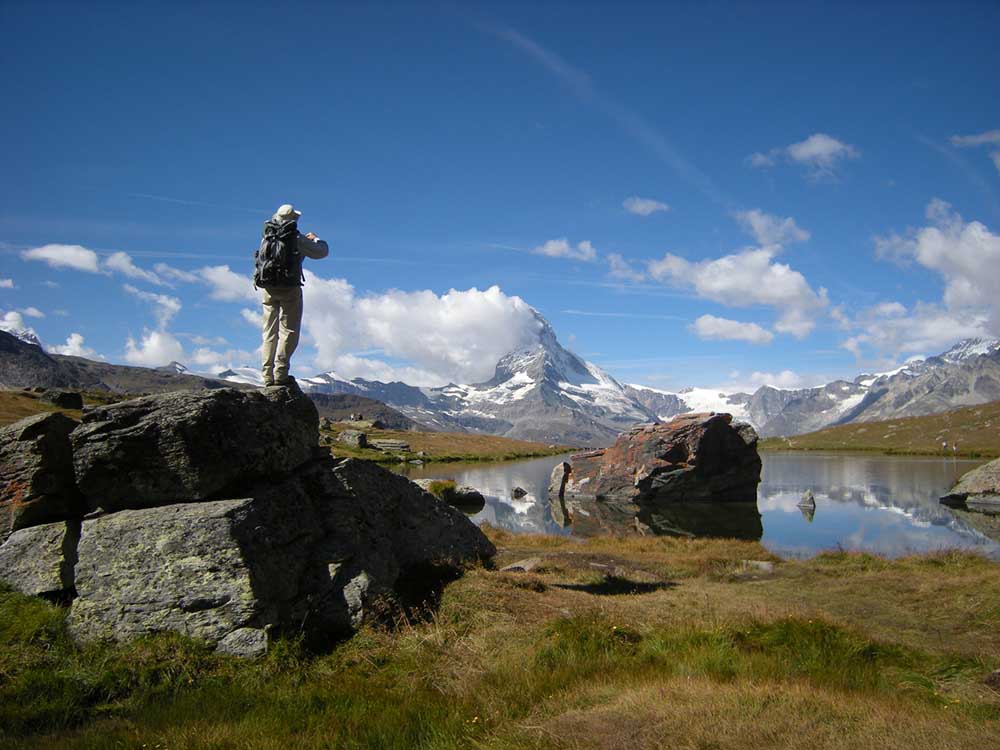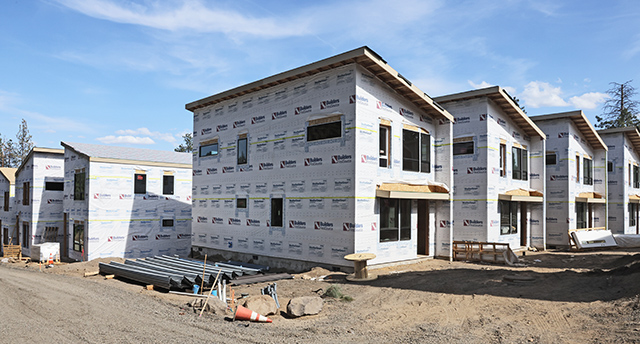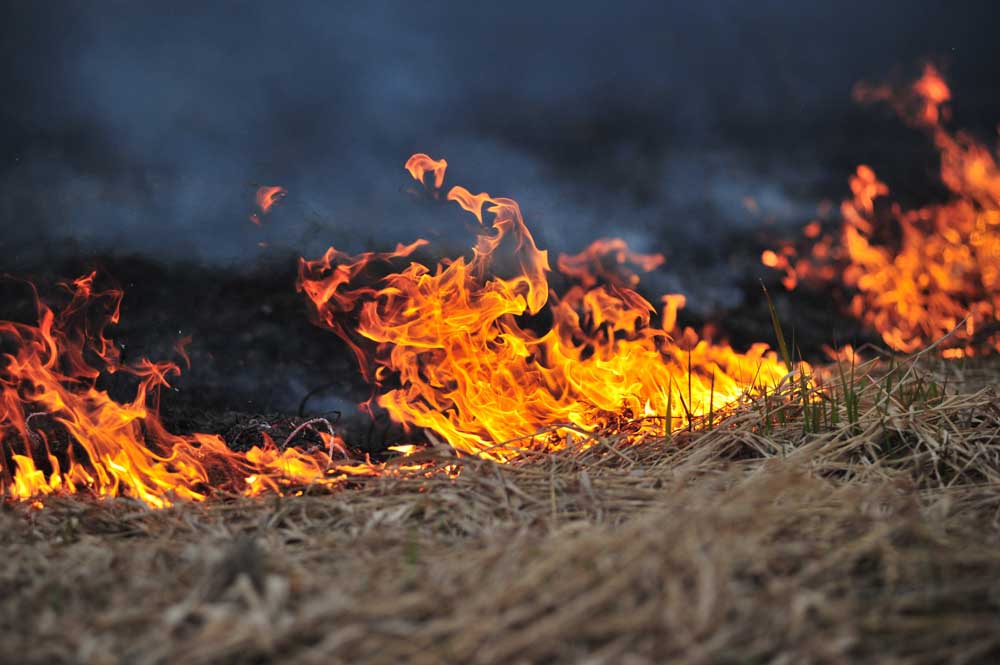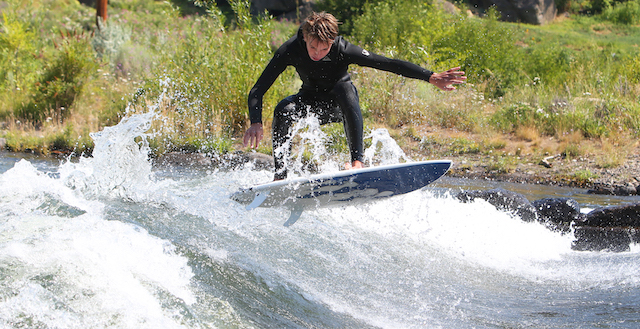Hiking the Alps from the Matterhorn to Mont Blanc
Published 12:00 am Sunday, February 8, 2015

- Lindy Washburn / The (Hackensack, N.J.) RecordThe Matterhorn viewed from the Gornograt formation.
The rope lies in coils on a red-velvet cushion, encased in museum glass, lit by a spotlight. It looks about the diameter of my pinkie finger. Its end is torn and frayed.
This was the safety line for the first party to summit the Matterhorn, on July 14, 1865. When it broke, four men plunged to their deaths.
In a race to the top of that peak, a seven-member British team ascended from the Swiss side, starting in Zermatt. Upon summiting, they spied their Italian competitors toiling up from the Italian side below and laughed and yelled and threw rocks. Then they began their descent.
That day changed the history of mountain climbing, the tiny Alpine village where the journey began and Swiss tourism. Its story is told at the Matterhorn Museum in Zermatt, where the 150th anniversary of that first ascent will be marked with an open-air play and the dedication of a new climbers’ lodge at base camp.
Besides the rope — displayed with the solemnity befitting a religious icon — a prescient Zermatt hotelier saved other artifacts from the climb, including one surprisingly small and alarmingly smooth-soled leather boot. There is also a transcript of the inquest, which blamed the least experienced member of the party, 19-year-old Douglas Robert Hadow, for the deaths. The body of one of the climbers — 18-year-old Lord Francis Douglas — was never found.
That history was much on my mind during a late-summer trip to three of the Alps’ classic peaks and — just as important — the charming towns from which each is approached: the Matterhorn with its resort community of Zermatt; the Jungfrau and the tiny carless village of Murren, in Switzerland; and Mont Blanc, above Chamonix, in France.
There were no ropes, frayed or otherwise, for us this vacation — we hiked, rather than climbed. Our most technical equipment consisted of knapsacks, hiking poles (I used them; others preferred not to) and some well-broken-in boots. Each morning, we headed out from town on hikes of varying length and difficulty, then returned in late afternoon to five-star meals, eiderdown quilts and rooms with a view.
A bounty of options
The Swiss are the inventors and exemplars of “hiking with options” — a philosophy that I heartily embrace. If you are eager to cut the day short after too many hours in an Alpine rain, you can board the cog railway back to town sooner than you’d planned. If your knees are sore after too many switchbacks up the side of a mountain, just take the gondola down.
Not only are the Alps crisscrossed with well-marked Wanderwegen, or hiking trails, but they’ve also nearly all been conquered by one or more forms of transportation. The Swiss (and French) have dug tunnels, laid track and flown aerial cables to even the most daunting locations.
Europe’s highest-elevation train station is near the top of the Jungfrau, reached through a tunnel more than four miles long through the Eiger and the Monch. Mont Blanc, the Alps’ highest peak, is approached via a two-stage cable-car ride from Chamonix. The conveyances we rode included gondolas and funiculars, cog railways and narrow-gauge trains.
But mostly we were powered by our own two feet.
For the Swiss portion of our trip, my husband and I joined a guided hiking tour organized by Alpinehikers, a small company founded and owned by Troy Haines, of Prescott, Arizona, who fell in love with the Alps while a student in Germany.
I booked the trip a month ahead, after earlier plans with Mountain Travel Sobek were canceled when too few people signed up. Alpinehikers never cancels a trip, Haines said.
Ours was a small, congenial group of five, plus the guide, Matt Brown, who skillfully accommodated the varying energy levels of members ranging in age from 24 to 70.
More important, perhaps, he made fabulous lunches. Each day, when we arrived at some incredibly scenic spot, he’d pull a little drawstring bag for each of us from his backpack. It included a chunky sandwich stuffed with Alpine cheese, cold cuts and shredded vegetables, an apple or pear and a much appreciated hit of Swiss chocolate.
In fact, it was while picnicking at Schwarzsee, the inn near the Matterhorn base camp, that I learned that Toblerone chocolates mimic the triangular shape of that mountain and are packaged in the yellow-and-red of that famous inn.
No groups, please
If you’d rather not travel with a group or a guide, Alpinehikers also offers self-guided itineraries. The company books the inns and suggests a route (with options!), accompanied by detailed directions. There are overland, inn-to-inn routes, usually with baggage transfers, as well as village-based hikes for both the self-guided and guided tours.
Or go it on your own. Route maps are free for the taking at train stations, English is commonly spoken, and yellow trail signs throughout the mountains point the way to various destinations, including farms, sleeping huts and mountain passes.
But I wouldn’t hesitate to join a hiking group again, despite my general aversion to group travel. Strung out along a trail, you can choose to converse or be alone with your thoughts. Ariane, our long-legged 20-something Australian companion, brightened each day with her enthusiasm. And Alan and Becky from Roanoke, Virginia, retired “active” vacationers, as they said, became our newfound friends. There were times — I admit it — when it was fun to have six voices belt the soundtrack from “The Sound of Music.” We were in the Alps — how could we not?
Our starting point was Murren, reachable by train from Zurich. For those unfamiliar with the Swiss rail system, it works like — dare I say it — clockwork. We bought rail passes and made connections at the Zurich Airport. After arriving at Interlaken Ost, a busy junction, we took a connecting train to Lauterbrunnen, a gondola ride up the side of a mountain, and then a half-hour narrow-gauge train trip into Murren, in the heart of the region known as the Bernese Oberland.
We gathered the first night at the Hotel Edelweiss in Murren, perched atop a cliff from which paragliders jump in swirling descents to the Lauterbrunnen Valley. The balcony of our room overlooked a 2,000-foot drop — with views of the Eiger to the left, the black face of the Schwarz Monch directly opposite and the Jungfrau to the right.
Murren has two roads: high and low, each lined by a pleasing mix of traditional chalets and newish small hotels and inns. Shop windows along the circuit showcase Murren’s Mini Museum, a series of exhibitions unfortunately exclusively labeled in German. But we appreciated the photos of the village’s famous mountain guides and the British Alpinists who’d scaled nearby peaks and parsed out a bit of the village’s history housing Italian internees in its vacant inns during World War II.
Surreal surroundings
That first evening, after a getting-to-know-you dinner, the setting sun reflecting from clouds onto the high glaciers created a pink light: alpenglow.
And the next morning, the hills came alive.
Our hike ascended gradually out of town, heading toward a lodge called Rotstockhutte. We gained an almost aerial view of the village of Gimmelwald, made famous by travel writer Rick Steves, and eyed the vast snow-covered flanks of the Jungfrau. Then, as lunchtime approached, we crested a ridge and descended into a grassy field where cattle munched and wandered, each with a wide cowbell tied around its neck.
That symphony of cowbells created a travel moment so perfect it was almost holy: deep, gonglike tones rang out a random melody; placid, brown-eyed bovines grazed contentedly in the flower-dappled meadow; a dome of turquoise sky arced above, and, in the distance, walls of jagged white encircled the scene. My contribution to this harmony was the rhythmic crunching of my hiking boots on the rough trail — and the click of my camera shutter.
The next day, of course, it rained.
Though we didn’t make it all the way to Kleine Scheidegg, the peak above Wengen that was our goal, we found a snug trackside inn in which to dry out and sip hot chocolate while waiting for the narrow gauge train to descend from the Jungfraujoch.
In Zermatt, a larger and more densely developed resort that evokes apres ski life even in summer, smokelike wisps of cloud at the Matterhorn’s peak changed to billowing clouds as the day advanced. The French doors of our room at the Hotel Europe framed the ever-changing view.
Matt told us the next morning he’d seen climbers’ headlamps before 5 a.m. heading out from the Hornlihutte lodge at the mountain’s base camp.
Later, after a long and beautiful hike to Schwarzsee, we watched through binoculars as red-jacketed forms descended the Hornli ridge.
Each year, hundreds of climbers attempt the peak, and about a dozen of them die. An estimated 500 climbers have perished on the mountain since those first four in 1865.
A stark reminder of those dreams cut short can be found at the climbers’ cemetery in Zermatt, where the headstones tell the tales.
From Zermatt, after a sad farewell to our hiking companions, the two of us continued on via train — and five short transfers — to Chamonix. It was a journey that carried us from the German-speaking region of Switzerland to the French and then across the border into France.
In Chamonix, climbers walk the streets with coils of rope slung over their shoulders and carabiners jangling from their belt-loops. The main roads are named after the two Frenchmen who first summited Mont Blanc.
Atop that mountain — reached in a 20-minute cable-car ride that ascends 8,900 feet — the cold is bracing, the air thin, and the view staggering. The glacier sweeps in parabolas of white toward the saw-toothed ranges in the distance. The wind howls. It feels like the knife-edge of the world.
The Museum of Alpinism, tucked into the visitor center where the gondola ends, shows how far equipment — and thrill-seeking — has come since the British conquered the Matterhorn.
With helmet-cam videos, the displays bring you into the action of free climbs (without ropes or gear), ice climbing, slack-lining and base-jumping.
But the best part, for me, was the doorway to the high Alps: a room from which climbers set out for their careful walk across the glacier and climb up the peaks.
It was like being in a locker room before the big game, as guides helped clients fasten crampons to their boots, coil their ropes and sling ice-axes into the loops of their packs.
A century-and-a-half has passed since the Alps, in all their dangerous glory, became a global destination and sensation. But standing there atop Mont Blanc, the ceiling of Europe seemed as fresh and exciting as it must have when Hadow, Lord Douglas and their colleagues set off in 1865.






